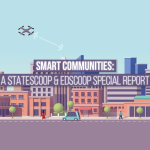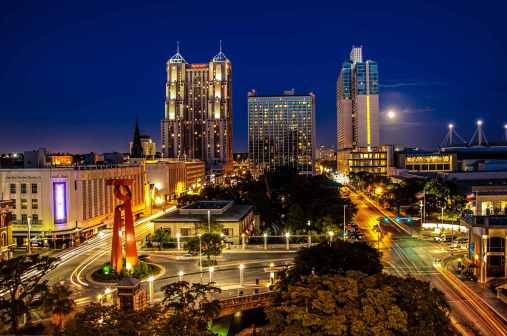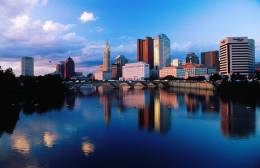Columbus, Ohio shares the plan behind its $500 million smart city portfolio

Columbus, Ohio, is far from a backwater. It’s a city of 860,000 residents, home to one of the biggest public universities in the country and capital of one of the top manufacturing states. But it’s not exactly top-of-mind when you think of the ideal 21st-century city.
That changed in 2016, though, when Columbus beat out 77 other cities for a $40 million grant from the U.S. Department of Transportation with its plan to remake its transportation systems with electric and (eventually) autonomous vehicles and new, rapid bus lines that connect residents of previously neglected low-income communities with commercial corridors and health services.
The grants sparked a flood of additional investment from public and private sources aimed at making Columbus the model of the smart-city movement. American Electric Power, Ohio’s largest power utility, is spending $200 million to modernize its grid and outfit nearly 900,000 residences with new meters that allow customers to monitor their usage on computers and mobile devices; the city government is replacing its street lights with efficient LED bulbs and environmental sensors; Honda and Ohio State are building an autonomous-vehicle test ground. So far, the city estimates nearly $500 million has been pledged, with the goal of hitting $1 billion by 2020.
Overseeing it all is Michael Stevens, the city’s chief information officer who returned to Columbus in 2017 after a stint in economic development outside Chicago. As the person in charge of Columbus’s smart-city initiatives, Stevens has a lot of new toys at his disposal, but he says he’s focused on making sure everyone in Columbus can enjoy the benefits. In an interview with StateScoop, Stevens says some of the benefits are already manifesting themselves, like the ability to provide low-income pregnant women better access to prenatal medical care, a vital step toward reducing the city’s high infant-mortality rate. He’s also getting ready to implement a new operating system for the city’s transportation network that’ll allow Columbus officials to harness data that can then be used to bring all residents along for the modernization.
In a phone interview, Stevens tells StateScoop one of his top goals is to make sure people aren’t left behind by all the technological disruption that’s hitting the ways cities like Columbus work. The added challenge is that the region expects to take on an additional million residents by 2050. The keys, he says, are new forms of mobility and a whole lot of data. “We think we’ll utilize this data,” Stevens tells StateScoop, “so we can come together to achieve our vision of empowering residents to live their best lives here.”
Considering the pace at which things are moving and how officials like yourself talk about how important things like electric vehicles, open data and other new technologies are to cites, should we maybe treat smart city innovations like the next wave of critical infrastructure?
It’s about doing that while making efficient investments. The nice thing about the advancements in technology now is that cities can be efficient but effective in serving our residents. Making sure we can provide services to all walks of life.
In your case a lot of what you’re doing revolves around electric vehicles. Why that specifically?
It’s important and really helpful that we have alliances and partnerships. Working with the Paul Allen Family Foundation, we’ve identified the fact that to reduce greenhouse gases we can increase the number of electric vehicles, and also partner with local utilities and not only modernize our growth, but include renewable energy sources. That’ll have a positive impact on our environment and sustainability.
When we think about how cities are changing, we often think about the kinds of change that are most visible to get distributed across all segments of Columbus’s economy. Do you ever worry some people could get left behind?
First of all, we’re engaging the communities. We’re providing prenatal care visits. We’re trying to look at what the problems are so we can use the tools of technology available to solve those problems. Not identifying solutions in search of a problem, but engaging our communities and understanding what their problems are and determining a solution. That way we’re ensuring we’re going into those opportunity neighborhoods where needs for improvement are most apparent, as well as neighborhoods across the city. We’re tactically using it so we’re impacting our residents across the socioeconomic spectrum.
Is that something you’re taking cues from the mayor on?
Mayor [Andrew] Ginther has really led the effort and from the start has focused on what can we do. He leaned in on making sure we were competitive in the Smart Cities Challenge, that we have the right partners at the table. The mayor’s interested in what we’re doing to use the technology in positioning the city in a way the disruption in technology doesn’t lead to a greater disparity but actually reduces the economic disparity so we can grow the middle class and have a much more balanced economy.
Where do you see these disruptions happening?
The biggest one is around mobility. We’re seeing a lot more whether it’s the electric vehicle work, or the autonomous, self-driving vehicles. We’re trying to encourage change where people will base consumption around more of a sharing economy. So ride-sharing, bike-sharing car-sharing. And reduce the number of single-occupancy trips occurring. Because as we continue to grow, our regional planning commission estimates we’ll be adding a million more people by 2050. To accommodate that kind of population growth, we just can’t build our way out. We have to utilize the different technology disruptions, whether it’s self-driving vehicles, connected vehicles, a shared approach to transportation. And then you need to expand the services provided, like micro-transit opportunities.
Adding 1 million people to any metro area is a huge burden. How do you equip the city to handle that kind of growth?
A lot of different ways. We’re focused on identifying changing the mobility that’ll impact people’s habits. How can we make sure that we’re positioned in a way we take advantage of? We can’t just build and build and build. How do you invest in infrastructure smartly that’s going to accommodate that growth? There’s going to be some density and mobility tools. That’s the reason our community is rallying around this initiative, to make sure we’re on the edge of what’s going on.
With all this innovation and new technology coming in, do you worry about making sure Columbus is able to weather all this change?
We know as we grow in population, how are we going to address our housing? How are we going to address our infrastructure? And if you can work together to get in front of it, you can address it before it becomes a problem or crisis. As you grow as a region and city, there are impacts on the services you provide that you worry about that you want to make sure you’re effective in providing.
I think when people think of Columbus they know Ohio State and that it’s a state capital. But who’s moving to Columbus? You’re making a play for Amazon.
One of the things that pushes us to the forefront is that there’s seeding investment going on in new technology and thought leadership and advancing technology and accepting it and embracing it. Clearly it’s growing and succeeding as opposed to trying to fight change. I think for the last 18 months we’ve had some success.
What are we going to see next from the Smart Columbus project?
In 2018 you’re going to see a lot around our smart operating system. That’s the backbone of our project portfolio. It goes beyond the project work of U.S. DOT. That operating system is going to collect data from both the public and private sector, the nonprofit sector. It’s important to remember that when we apply data to challenge the experience of cities, we can transform outcomes like children’s health care, even things like access to healthy food. We think we’ll utilize this data, make it accessible to application developers, startups, researchers at the university, so we can come together to achieve our vision of empowering residents to live their best lives here.
It sounds like you’re not just thinking about 2018, but you’re thinking about 2019, 2020…
That’s both short-term and long-term. You’re going to see a lot of activity around the operating system. We’re rolling out this summer an experience center in downtown Columbus to demonstrate and give our residents an opportunity to come in and use some of this technology we’re talking about. And as we get more partners for it to demonstrate technology, that’s going to be something in the near term. We’re going to continue to engage our residents, particularly on projects like prenatal care visits and smart-mobility hubs.
A couple years ago, Columbus’s economic development bureau ran an ad campaign in the D.C. Metro bragging that it was the hip place to be. Not to inflame an old rivalry, but I’m wondering if I should be a bit worried D.C. is the one that winds up being less cool.
Yeah. The great thing about doing the smart city work is that economic development is obviously very competitive, but from the smart city perspective, the approach is that as we’re learning, we’re happy to share with others. As we find best practices we want to share them with other communities so they can adapt. We can all be cool.
This interview has been condensed and edited for readability.

This story was featured in StateScoop Special Report: Smart Communities (2018)






